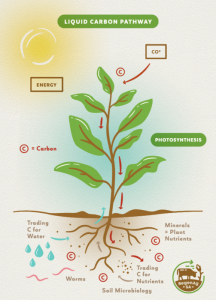Healthy Soil and Soil Carbon
Carbon in the soil is the most important indicator of healthy soil and productive land. Carbon is stored as stable polymers in the humus of soil. Humus is the completely broken down organic matter. Humus provides the biology in the soil with extra water holding capacity and structure so they have a healthy environment and can provide water and nutrients to plants. In agriculture, if soil has good levels of carbon, the soil is functioning with life, providing plants with the nutrients they need. The land manager has have less need for chemical inputs
Read on…
Every living thing is made of carbon and over time the dead plant matter and animal life die, and as they decay they become part of the organic matter in the soil. There is another process that we do not see that also builds humus and carbon in the soil.
Plants transform sunlight, CO2 from the atmosphere and water into carbohydrates, the energy they need to grow. It’s the process of photosynthesis. Plants also have a symbiotic relationship with the life in the soil, fungi and microorganisms, and they send anything from 30- 60% of these carbon sugars (exudates) down their roots as food for them. It’s a trade, the energy the fungi and microorganisms receive from the plants is traded for the minerals and nutrients the plant needs to grow. The array of fungi and microorganisms in the soil is huge, bacteria, protozoa, nematodes, worms, fungi and more not yet discovered, in various sizes from microscopic to large worms, all with different functions. These billions and billions of microorganisms and fungi live, poo, get eaten and die, and along with the decomposed matter form humus. Humus is approx 50-60%carbon. Dr Christine Jones labelled this process the Liquid Carbon Pathway, where carbon is transformed from a gas (CO2) in the atmosphere into a liquid (plant sugars) to a solid (humus).
The mycorrhizal fungi also produce aggregates with a sticky substance called Glomalin, only recently been discovered in 1996. It’s these aggregates that give the soil structure, enabling air and pathways keeping the soil healthy and aerobic for the organisms to thrive. Aggregates in the soil also provide increased water storage and faster water infiltration. When it does rain, it can be rapidly absorbed and stored. Each additional 1% increase in soil carbon per hectare (down to 30cm) can result in an additional 168,000 litres of water stored in the soil, making it more resilient to drought. It’s a cycle, with increased water and nutrients available to it the plant’s photosynthesizing capacity is increased, with increased plant growth sending more energy to the microorganisms in the soil, and the cycle continues.
A diverse range of plants is also important in encouraging a diverse range of microorganisms and fungi that are part of the soil food web that supports the nutrient and mineral needs of plants. And healthy soil requires little to no chemical inputs, the biology in the soil provides the plant with all the nutrition it needs and protects it against pests and diseases.
Healthy Soil, Healthy Plants, Healthy People.
The Liquid Carbon Pathway
(The Regenerative Agricultural Association of Southern Africa (RegenAg SA)

